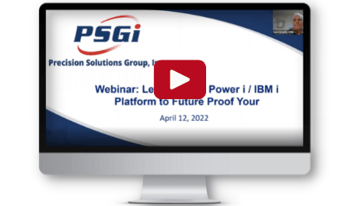 PSGi founder and co-President Larry Dube has decades of hands-on experience helping businesses leverage the Power i / IBM i platform to keep pace with their organization’s pace of change.
PSGi founder and co-President Larry Dube has decades of hands-on experience helping businesses leverage the Power i / IBM i platform to keep pace with their organization’s pace of change.
In our recent webinar, he condensed this experience into a practical presentation on how to harness the features that empower this ecosystem to stay flexible, continue adding new functionality, and keep pace with changing business requirements for years to come.
In this blog, we provide a concise summary of Larry’s presentation. Or, if you have the time, you can watch the recorded presentation using the button below.
Can your ERP software keep up with your business’s pace of change?
IT teams have always faced the challenge of enhancing existing ERP software to provide greater value in the face of ever-changing business requirements. Over the last few years, we have experienced an even more accelerated pace of change, and a flexible IT ecosystem is more important than ever. In this context, the items in your ecosystem that are least flexible are likely to drive the most operational vulnerability.
Many legacy ERP systems continue to drive outstanding value many years after they were initially implemented and continue to meet core business requirements. In many cases, these ERP systems have been heavily modified along the way, and possibly integrated with additional APIs to add additional functionality. These customizations are often conducted as “modifications of the moment,” that don't necessarily fit coherently into the organization’s long-term strategy. Moving forward, Larry recommends taking a systematic approach to planning ERP enhancements in the context of specific business requirements:
- Document Major Business Areas
- Build the Integration Layer
- Consider Each Customization an Opportunity
We explain each of these steps in more detail below.
Document Major Business Areas Where Added ERP Functionality Can Provide Strong Value
We recommend focusing on major business areas where new functionality can immediately start streamlining operations and driving tangible ROI. Some of the most common examples include:
- Order processing
- Purchasing
- Inventory Transactions
- Financial Transactions
In many organizations, ERP workflows have been done a certain way for as long as anyone can remember. The original reasoning (and the underlying data interactions) may be long forgotten. In short, many organizations don’t fully understand their existing ERP system. And in this context, a meticulous survey is crucial to generate the understanding needed for an effective long-term ERP improvement program. In many cases, organizations may already possess valuable functionality they didn’t know they had!
Adding valuable new features, such as ERP integration with incoming Purchase Orders, is often relatively straightforward. But it does require some in-depth knowledge of how data interacts between the ERP and external systems.
Smart Customizations: Teach an Old Dog New Tricks
An effective deployment methodology should take advantage of today’s hybrid ERP environment to add valuable functionality with speed and resiliency. Larry recommends centering this methodology on the deployment of focused microservices: independent testable functions that are related to a single business area.
These microservices may call existing programs, read existing data, or perform new functions. Crucially, these services should seek to stay small, agile, and independently testable. In contrast to large modifications and add-ons, this approach allows the business to quickly execute agile deployments in response to dynamic business needs. These services can be particularly valuable for integrating with partners such as banks, suppliers, and customers, where they can streamline communications and repetitive administrative tasks for years to come. And using the microservice approach, new functionality can be brought online in a matter of a few hours instead of a few months.
Look at Each Customization as an Opportunity
It can be difficult to sell building out the integration layer to stakeholders bearing the financial burden of specific microservice development projects. It can also be difficult to secure a budget for services built in advance “to be used later.”
In this context, Larry recommends looking at each small customization as a longer-term opportunity. If you are developing a microservice for one stakeholder, how can this effort be leveraged to generate value for additional stakeholders across the organization? Other key questions to ask include:
- How can we design the service to be broken down into very small, reusable parts?
- How can I structure data so that it can be used for other data flows?
- How can I adopt more acceptable data integration technologies?
- How can I separate my ERP layer from varied external technologies?
How to Leverage the Power of the Power i / IBM i Platform to Future-Proof Your ERP
The agile, micro-service-based strategy outlined above is well suited to the Power i / IBM i ecosytem, which offers powerful features that simplify continuous ERP improvement. The webinar focuses on security and integrability as two illustrative examples.
Example One: Security
New threats are emerging faster than ever, and IBM i offers robust built-in security features. Crucially, security controls are in place at the system level, database level, and via access control.
Regular, effective security audits are a great way to improve your ERP’s ability to quickly adapt to new requirements in the future. An ongoing audit “layer” allows the organization to be more adaptable: the right protection is already in place to streamline adding new functionality while keeping sensitive data safe. Everything from password usage, to access management, to encryption, to database layer security (ie. Row and Column Access Controls) should be included in audits.
Example Two: Easy Integrations
From SQL-based API’s, to integrated web services, and even AI-based resources like Watson, the IBM i environment has many options for integrating powerful new functionality.
An open-source resource repository contains code for many common integration tasks (Larry provides a full list in the webinar) and IBM i has also built in an increasingly broad array of services over the years.
One common example of a high-value integration project is the supply chain. As supply chain issues continue to proliferate in the global economy, more and more organizations will benefit from the ability to quickly tag items experiencing a supply chain issue, allowing for prompt communication with customers (and even direct integration with the customer service group). These capabilities can be readily expanded to broader supply chain integration tasks, sharing data with suppliers and customers alike in real-time.
We hope this webinar summary has provided some valuable insight! If you are interested in further detail, you can watch the full recorded webinar here. Or, if you prefer to reach out to the PSGi team to discuss your future ERP plans, just use the button below.



